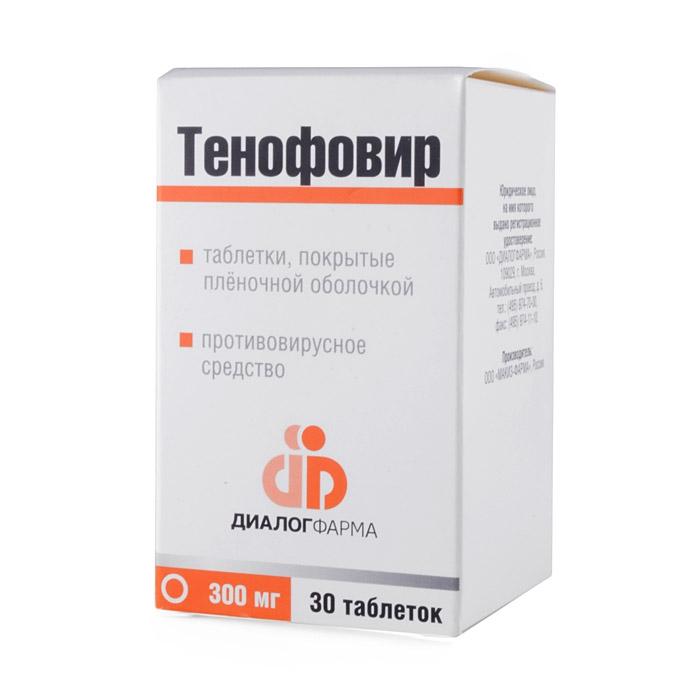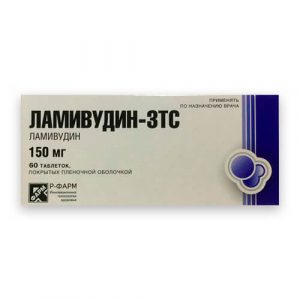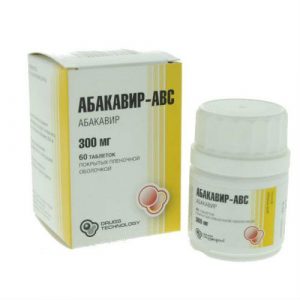Description
Latin name
Tenofovir
Packaging
30 tablets
Pharmacological action of
Pharmacodynamics of
Tenofovir disoproxil fumarate in vivo is converted to tenofovir, an analog of nucleoside monophosphate (nucleotide) adenosine monophosphate. Tenofovir subsequently turns into an active metabolite – tenofovir diphosphate.
Tenofovir, a nucleotide reverse transcriptase inhibitor, has specific activity against the human immunodeficiency virus (HIV-1 and HIV-2).
Pharmacokinetics of
When administered on an empty stomach, the bioavailability of tenofovir is approximately 25% and up to 40% (with food) is improved when taken with food, especially with a high fat content.
Eating does not have a clinically significant effect on the effectiveness of tenofovir.
After a single oral fasting dose of 300 mg, the maximum concentration in blood serum is reached after 1 ± 0.4 hours. The pharmacokinetics of tenofovir is dose-dependent in nature. The elimination half-life (T1 / 2) of the cell -> 60 h
After a single oral administration of tenofovir, T1 / 2 tenofovir – approximately 17 hours. After repeated oral administration at a dose of 300 mg once a day (under conditions of administration not on an empty stomach), 32 + 10% of the dose taken is determined in the urine for more than 24 hours.
Tenofovir is excreted by the kidneys, by glomerular filtration and active tubular secretion.
Indications
Treatment of HIV-1 infection as part of combination antiretroviral therapy in adults.
Contraindications
Tenofovir is contraindicated in patients with hypersensitivity to any component of the drug.
Precautions
Renal failure with creatinine clearance less than 50 ml / min, including patients on hemodialysis. With creatinine clearance less than 30 ml / min, the use of the drug should be avoided if other treatment is not available, kidney function should be carefully monitored and the interval between drug administration should be adjusted.
Use during pregnancy and lactation
When deciding on the use of the drug during pregnancy, it is necessary to correlate the expected therapeutic effect for the mother with the possible risk of using the drug for the fetus.
In connection with the revealed changes in bone tissue while taking the drug, and with limited experience of use, it is recommended to use the drug with caution during pregnancy.
Women of childbearing age should use reliable methods of contraception during treatment. Nursing mothers: HIV-infected women should be instructed to exclude breastfeeding.
Composition
Active ingredients:
Tenofovir disoproxyl fumarate 300.0 mg
Excipients:
– Croscarmellose sodium 40.0 mg
– Lactose monohydrate 153.33 mg
cellulose 33rd cellulose mg
– Magnesium stearate 6.67 mg
– Opadry II light blue (Titanium dioxide – dye
FD&C blue No. 2,
aluminum lacquer certified in accordance with the law FD&C (FD&C Blue # 2 Aluminum Lake) – dye
Gipromellose srd monohydrate (Lactose Monohydrate) –
filler Triacetin (Triac etin)) 32.0 mg
Dosage and administration
Inside, regardless of food intake.
Recommended dose for treating HIV-1 infection: 300 mg once daily. Recommended dosage regimen for Tenofovir in renal failure: Creatinine clearance 30-49 ml / min: 300 mg every 48 hours. Creatinine clearance 10-29 ml / min: 300 mg every 72-96 hours. Hemodialysis: 300 mg every 7 days after the session dialysis.
There are no recommendations on the dosage regimen in patients with creatinine clearance less than 10 ml / min (without hemodialysis).
Side effects of
The following are the undesirable reactions with the suspected (possible) association with the drug, which are listed by systemic organ classes in decreasing order of severity, with the following frequency: very often (> 1/10) and often (> 1/100 , <1/10), rarely (> 1/10000, <1/1000), very rarely (metabolic and nutritional disorders: very often - hypophosphatemia. From the nervous system: very often – dizziness. From the gastrointestinal tract: very often – diarrhea, vomiting, nausea often – flatulence. Combined retrov tiered therapy has been associated with metabolic disorders such as hypertriglyceridemia, hypercholesterolemia, insulin resistance, hyperglycemia, and hyperlactatemia by redistribution of subcutaneous tissue (lipodystrophy). Cases of osteonecrosis have been reported, especially in patients with risk factors or with prolonged combination antiviral therapy. The frequency is unknown. Post-marketing experience Disruption of metabolism and nutrition: rarely – lactic acidosis, frequency unknown – hypokalemia Respiratory, thoracic and mediastinal disorders: very rarely – dyspnea. From the gastrointestinal tract: rarely – pancreatitis. From the hepatobiliary system: rarely – increased transaminase activity is very rare – hepatitis, frequency is unknown – liver steatosis. From the skin and subcutaneous tissues: rarely – rash. From the musculoskeletal system: frequency unknown – rhabdomyolysis, osteomalacia, muscle weakness, myopathy. From the urinary system: rarely – acute renal failure, proximal renal tubulopathy (including Fanconi syndrome), hypercreatininemia is very rare – acute tubular necrosis frequency is unknown – nephritis (including acute interstitial), nephrogenic diabetes insipidus. General disorders and changes at the injection site: very rarely – asthenia. Drug Interaction Didanosine: An increase in the concentration of didanosine when co-administered should be used with caution and control of the manifestations of didanosine toxicity (eg, pancreatitis, neuropathy). The combination of tenofovir with didanosine is not recommended if warranted, a dose reduction or discontinuation of didanosine should be considered. Tenofovir is combined with reduced doses of didanosine (for example, patients with a body weight> 60 kg are prescribed didanosine 250 mg once daily <60 kg - 200 mg once daily). On the other hand, such a low-dose combination may is characterized by low antiviral activity and insufficient increase in the amount of C04-lymphocytes, as indicated by the high frequency of therapy inefficiency when using this combination with the addition of efavirenz or nevirapine. Atazanavir: decreased co-administration of atazanavir and increased tenofovir concentrations. It is necessary to use tenofovir with atazanavir only with additional enhancement of the effect of the latter ritonavir. Lopinavir / ritonavir: Increased concentrations of tenofovir when co-administered. Darunavir: Increases tenofovir concentration by 20-25%. The drugs should be used at standard doses, and the nephrotoxic effect of tenofovir should be carefully monitored. Tenofovir is mostly excreted through the kidneys, the combined use of tenofovir with drugs, that reduce renal function or reduce / discontinue active tubular secretion may increase serum tenofovir concentration and / or increase concentrations of other drugs excreted by the kidneys. Ganciclovir, valganciclovir and cidofovir compete with tenofovir for active tubular secretion by the kidneys, resulting in increased levels of tenofovir or a concomitant medicinal product requiring alertness to possible side effects. Nephrotoxic drugs can also increase the concentration of tenofovir in serum. Overdose In case of overdose, the patient should be examined for possible signs of intoxication. Standard supportive therapy is used as needed. Tenofovir is effectively removed by hemodialysis with an extraction rate of approximately 54%. After receiving 300 mg of tenofovir, a 4-hour hemodialysis procedure results in the removal of approximately 10% of the administered dose of tenofovir. Storage conditions At a temperature not exceeding 25 ° C. Keep out of the reach of children. Expiration 2 years. Deystvuyuschee substances Tenofovir dosage form Dosage form tablets



